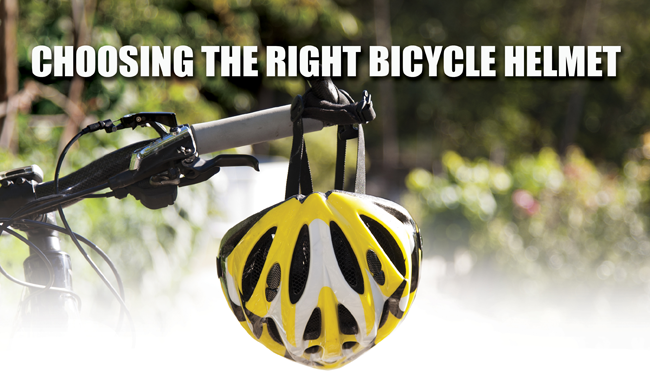Your head is probably worth reading this!
You should absolutely ALWAYS wear a helmet wherever you ride. Even a low-speed fall on a bicycle can scramble your brains. Statistics show the average cyclist can pretty much expect to experience a crash, sooner or later and head injuries cause 75% of bicycle deaths. Not surprisingly, research shows helmet use has been estimated to reduce head injury risk by 85% — and at least 21 states and Washington, D.C., even have laws requiring them. Helmets simply make sense in all riding conditions.
Which Type…Sport, Mountain or Road?
Cycling helmets come in 3 basic styles: sport, road and mountain, but they all share the same basic function
of protecting fragile skulls from unexpected encounters with the road or trail. The differences are:
| 1- Sport or Multi-Use Helmets(price range from $30-$60)An economical choice for recreational, commuter, road and mountain bikers; also popular with skateboarders and inline skaters.2 – Mountain Bike Helmets(price range from $40-$250)Designed for good ventilation at low speeds; distinguished by their visors, enhanced rear-head coverage and a secure fit for tackling rough terrain. Often used by cyclocross riders, too.
3 – Road Bike Helmets (price range from $80-$300) Preferred by roadie enthusiasts for their low weight, generous ventilation and aerodynamic design. |
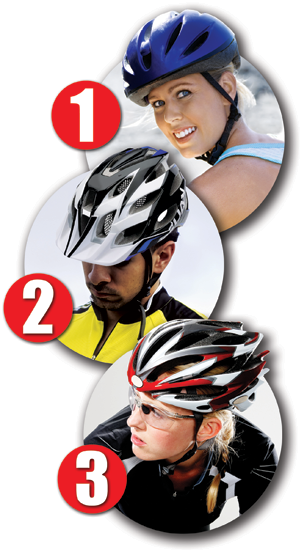 |
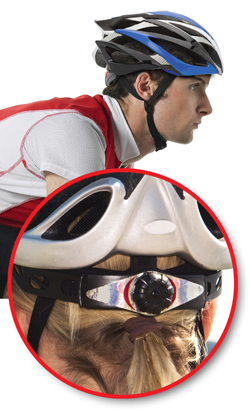 |
Make sure your helmet fits snug, but not too tight. A good fit means level on your head, touching all around your head comfortably. The helmet should not move more than about an inch in any direction, and must not pull off no matter how hard you try.
Most helmets have a retention system, to ensure the helmet fits properly and stays in place in the event of a crash. Most adjustments are taken care of by either a turn-wheel of some sort or little ratchets that control the adjustable band around the head. Find the Right Size Lower-priced helmets are often one-size-fits all; you simply adjust an internal strap to get the helmet snug. Higher-priced helmets are available in a range of sizes. To learn what size you need, measure your head: wrap a flexible tape measure around your noggin just above your ears. Make sure the tape is level – it should cross your forehead an inch or so above your eyebrows. Then, choose a helmet size to match the measurement. |
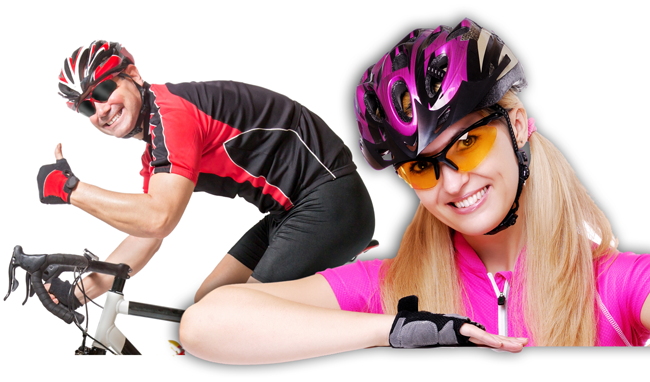
Looking Good
Most riders probably won’t admit it, but the look and feel of the helmet is just as important as how well it protects their grey matter. Some things to consider are color (bright colors are good); cut (do you need something that covers the back of your head, or a full face mask for downhilling?); and ventilation (if you overheat easily, the more vents the better). Do you care to have a visor on the front of the helmet? Generally speaking, roadies don’t, mountain bikers do. But that is a matter of personal preference. These are not the most important decisions you’ll make if you take a hard fall. But how you look and feel out on the trail is still something to think about.
brow pad or separate sweatband.
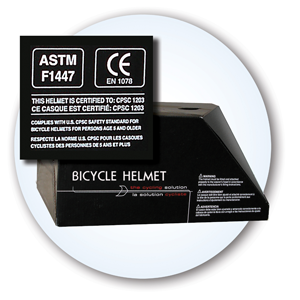 |
Helmet StandardsCheck the label on the box…if it says “BICYCLE HELMET” it needs to meet the standards of the Consumer Product Safety Commission. It’s a law in the United States. If you’re buying a bike helmet, rest assured that a low-cost helmet meets the same safety standards as a pricey, high-end helmet. Need reassurance? Look for a CPSC (US Consumer Product Safety Commission standard ) sticker. ASTM’s F1447 standard is also used and is identical.Weight
Weight is almost always listed in grams (28.34g = 1 oz.). While weight is not really a big concern for the occasional cyclists, racers and frequent riders really appreciate the weight savings of a lighter helmet. Just remember, as the weight goes down, the price goes up. |
Comfort Requirements
Coolness, ventilation, fit and sweat control are the most critical comfort needs. Air flow over the head determines coolness, and larger front vents provide better air flow. Most current helmets have more than adequate cooling for most riders. Just keep in mind, the more vents, the cooler the head (and the pricier the helmet). Sweat control can require a brow pad or separate sweatband.
| A Few Helmet Tips
Avoid using chemical solvents to clean a helmet. Manufacturers recommend only the use of a soft cloth or sponge, plus mild soap and water. In Conclusion Though wearing a helmet doesn’t protect one against all injuries, studies do suggest that many head, skull and brain injuries can be prevented or minimized with helmet use at the time of a crash. So, find a helmet with a snug, comfortable fit and always wear it when you ride. |
 |
Sources:
How Helmets Work: Bicycle Helmet Safety Institute(BHSI)
BHSI Quick Answers www.bhsi.org/quick.htm
BHSI Statistics www.bhsi.org/stats.htm
